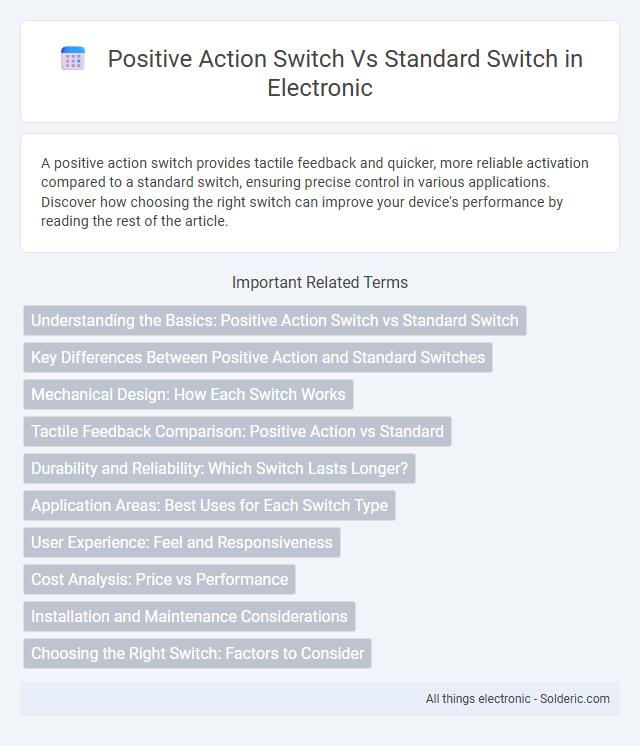A positive action switch provides tactile feedback and quicker, more reliable activation compared to a standard switch, ensuring precise control in various applications. Discover how choosing the right switch can improve your device's performance by reading the rest of the article.
Comparison Table
| Feature | Positive Action Switch | Standard Switch |
|---|---|---|
| Mechanism | Requires deliberate force to change state | Changes state with minimal force |
| Feedback | Distinct tactile feedback | Less pronounced tactile feedback |
| Reliability | Reduces accidental activation | Higher risk of unintended switching |
| Typical Usage | Safety-critical applications (e.g., industrial controls) | General-purpose electronics |
| Cost | Generally higher due to robust design | Lower-cost option |
| Durability | Enhanced lifespan under repeated use | Standard durability |
Understanding the Basics: Positive Action Switch vs Standard Switch
Positive action switches provide tactile or audible feedback immediately upon actuation, ensuring precise control and reducing accidental activations compared to standard switches. Standard switches often rely on completing an electrical circuit without feedback, potentially causing uncertainty in user input. Understanding these differences helps you select the right switch for applications requiring accuracy and reliability.
Key Differences Between Positive Action and Standard Switches
Positive action switches provide tactile feedback by requiring full button depression for activation, reducing accidental inputs compared to standard switches. These switches typically utilize an internal mechanism that ensures consistent actuation points, enhancing typing accuracy and responsiveness. Your choice between positive action and standard switches influences typing comfort, durability, and input precision based on your usage preferences.
Mechanical Design: How Each Switch Works
Positive action switches feature a tactile mechanism that requires deliberate pressure to engage, enhancing precision and reducing accidental activations in your devices. Standard switches typically utilize a simple on-off mechanism with less tactile feedback, relying on basic contact points to complete the circuit. The mechanical design of positive action switches often includes a spring-loaded actuator that returns to its original position, whereas standard switches may lack this refined responsiveness.
Tactile Feedback Comparison: Positive Action vs Standard
Positive action switches provide distinct tactile feedback characterized by a noticeable "click" and a defined actuation point, enhancing typing accuracy and user confidence. Standard switches typically offer smoother, less pronounced tactile sensations, which may result in less precise key actuation. The clear tactile response in positive action switches reduces typing errors and improves overall efficiency compared to the subtler feedback of standard switches.
Durability and Reliability: Which Switch Lasts Longer?
Positive action switches offer superior durability compared to standard switches due to their enhanced internal mechanisms designed to reduce contact wear and resist environmental factors like dust and moisture. The consistent tactile feedback in positive action switches ensures reliable performance over millions of cycles, making them ideal for rigorous daily use. Your choice of a positive action switch can significantly extend the lifespan and maintain the reliability of your device or system.
Application Areas: Best Uses for Each Switch Type
Positive action switches excel in safety-critical applications such as aerospace, medical devices, and industrial machinery where deliberate actuation is vital to prevent accidental engagement. Standard switches are more suitable for general consumer electronics, household appliances, and low-risk industrial equipment due to their simplicity and cost-effectiveness. Selecting the appropriate switch type depends on the required reliability, user interaction, and potential consequences of accidental activation.
User Experience: Feel and Responsiveness
Positive action switches provide a more tactile and consistent feel compared to standard switches, enhancing your typing accuracy and speed. Their distinct actuation point ensures rapid responsiveness, reducing missed or accidental key presses. This improved feedback significantly elevates the overall user experience, especially during prolonged use.
Cost Analysis: Price vs Performance
Positive action switches generally command higher prices due to their enhanced tactile feedback and durability, which improve user experience and reduce long-term maintenance costs. Standard switches, while more affordable upfront, may exhibit quicker degradation and less consistent performance, potentially leading to additional replacement expenses. Evaluating total cost of ownership reveals that positive action switches often deliver better value by balancing initial price with superior performance and longevity.
Installation and Maintenance Considerations
Positive action switches offer precise tactile feedback and consistent operation, making installation easier by reducing adjustment errors compared to standard switches. Their robust design typically requires less frequent maintenance, improving long-term reliability in your control systems. Standard switches may require more careful calibration and occasional upkeep due to less defined contact engagement, potentially increasing downtime.
Choosing the Right Switch: Factors to Consider
Selecting between a positive action switch and a standard switch involves evaluating factors such as tactile feedback, actuation force, and durability requirements. Positive action switches typically offer distinct feedback and quicker responsiveness, making them ideal for environments where precision and user confidence are critical. Consideration of application context, user preference, and long-term reliability will guide the optimal switch choice.
positive action switch vs standard switch Infographic

 solderic.com
solderic.com